#chasmosaurinae
Text

Day 2: Kosmoceratops
But with memory vs. reference in lineart.
Do not use my art as base or something like that.
#my art#dinosaur#paleoart#myart#dinosaurs#dinosauria#my drawings#ornithischia#ceratopsia#ceratopsidae#Kosmoceratops#chasmosaurinae#dinocember#sketchbookapp#sketchbook app
43 notes
·
View notes
Text
‘Tis but a flesh wound!!
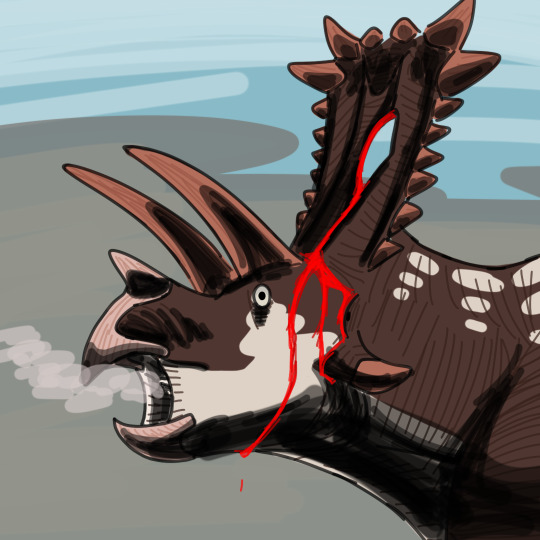
#pentaceratops#chasmosaurinae#ceratopsida#ceratopsian#dinosaur#paleoart#digital drawing#digital doodle#cw bl00d
17 notes
·
View notes
Text
Dinofact #110
Coahuilaceratops, a genus of chasmosaurine ceratopsian dinosaur, is thought to have possessed among the largest horns of any known dinosaur, even though it is based on incomplete remains. Its horns may have rivaled the size of those of larger chasmosaurines such as Triceratops and Torosaurus, at 1.2 m (4 ft) long.
Source: Wikipedia
#dinosaur#dinosaurs#paleontology#coahuilaceratops#chasmosaurine#chasmosaurines#chasmosaurinae#ceratopsian#ceratopsians#ceratopsia#horns#triceratops#torosaurus#fun facts#trivia#dinosaur trivia#dinosaur fun facts#25th#december#2022#december 25th#december 2022#december 25th 2022#records
15 notes
·
View notes
Text
also I'm sorry for forgetting elasmarians in ornithopods I promise to include them in the misc one
#dinosaurs#palaeoblr#prehistoric life#polls#marginocephalians#ceratopsians#pachycephalosaurs#triceratops#styracosaurus#protoceratops#psittacosaurus#pachycephalosaurus#et al
193 notes
·
View notes
Text
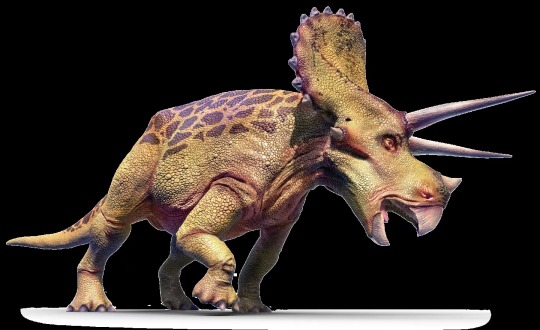

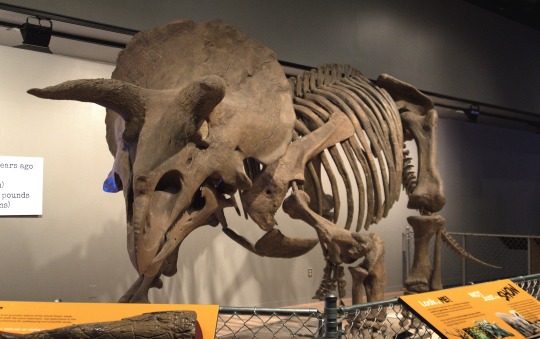
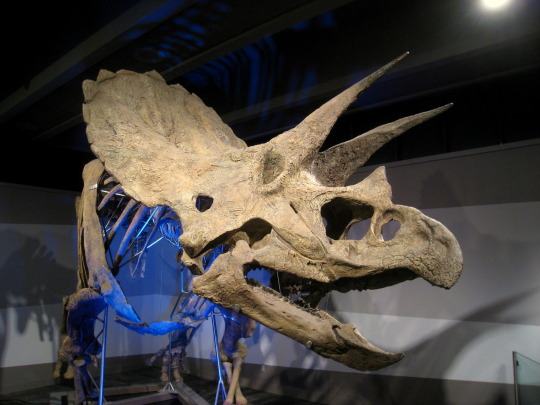

Triceratops
(temporal range: 68-66 mio. years ago)
[text from the Wikipedia article, see also link above]
Triceratops (/traɪˈsɛrətɒps/ try-SERR-ə-tops;[1] lit. 'three-horned face') is a genus of chasmosaurine ceratopsian dinosaur that lived during the late Maastrichtian age of the Late Cretaceous period, about 68 to 66 million years ago in what is now western North America. It was one of the last-known non-avian dinosaurs and lived until the Cretaceous–Paleogene extinction event 66 million years ago. The name Triceratops, which literally means 'three-horned face', is derived from the Greek words trí- (τρί-) meaning 'three', kéras (κέρας) meaning 'horn', and ṓps (ὤψ) meaning 'face'.
Bearing a large bony frill, three horns on the skull, and a large, four-legged body, exhibiting convergent evolution with bovines and rhinoceroses, Triceratops is one of the most recognizable of all dinosaurs and the most well-known ceratopsian. It was also one of the largest, up to 8–9 metres (26–30 ft) long and 5–9 metric tons (5.5–9.9 short tons) in body mass. It shared the landscape with and was most likely preyed upon by Tyrannosaurus, though it is less certain that two adults would battle in the fanciful manner often depicted in museum displays and popular media. The functions of the frills and three distinctive facial horns on its head have long inspired countless debates. Traditionally, these have been viewed as defensive weapons against predators. More recent interpretations find it probable that these features were primarily used in species identification, courtship, and dominance display, much like the antlers and horns of modern ungulates.
Triceratops was traditionally placed within the "short-frilled" ceratopsids, but modern cladistic studies show it to be a member of Chasmosaurinae, which usually have long frills. Two species, T. horridus and T. prorsus, are considered valid today. Seventeen different species, however, have been named throughout history. Research published in 2010 concluded that the contemporaneous Torosaurus, a ceratopsid long regarded as a separate genus, represents Triceratops in its mature form. This view has still been highly disputed and much more data is needed to settle this ongoing debate.
Triceratops has been documented by numerous remains collected since the genus was first described in 1889 by American paleontologist Othniel Charles Marsh. Specimens representing life stages from hatchling to adult have been found. As the archetypal ceratopsian, Triceratops is one of the most beloved, popular dinosaurs and has been featured in numerous films, postage stamps, and many other types of media.
4 notes
·
View notes
Text
'Cause who doesn't love Triceratops, that's why. \^/
Triceratops horridus
('three-horned face, rough/rugose')
Chasmosaurinae Triceratopsini
An animal that needs very little introduction as perhaps the most iconic of all herbivorous dinos (pipe down, sauropods). Triceratops is so well known and represented in the fossil record that in taxonomy the genus is a reference point for the definition of Dinosauria: dinosaurs as defined are literally all descendants of the most recent common ancestor of Triceratops and Neornithes/'modern' birds.
T-tops is represented by two species: T. horridus (type species), and T. prorsus ('straightforward').
Various formations, western Canada (Alberta, Saskatchewan) and USA (Colorado, Montana, South Dakota, Wyoming).
Upper Cretaceous, ~68 - 66 Ma.
~
Artwork by Vlad Konstantinov.
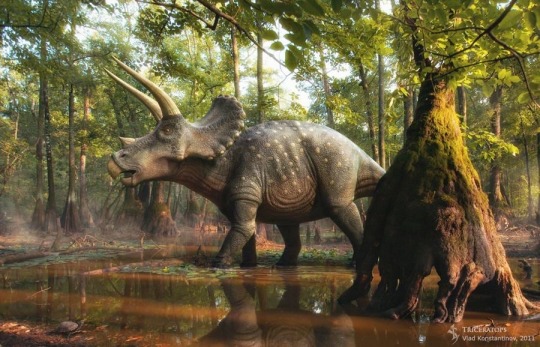
Daily Dino Fact #8
35 notes
·
View notes
Text
Episode 28 - Control
Welcome to the Juras-Sick Park-Cast podcast, the Jurassic Park podcast about Michael Crichton's 1990 novel Jurassic Park, and also not about that, too.
Find the episode webpage at: Episode 28 - Control
In this episode, my terrific guest Dan Rose joins to us chat with me about:
The story of the velociraptors in the seminal dinosaur film Jurassic Park (1993) by Steven Spielberg, post-production duties, Sinking Ship Entertainment, foley artists, Dennis Nedry's death scene, dilophosaurus attacks, the specific moment when Jurassic Park goes from fun-loving to Friday the 13th, the Dino Dana Movie, working with dinosaurs, Robert Muldoon, the Big One, the raptors in Jurassic Park, the film raptors v. the book raptors, all the raptor scenes from the movie, a little bit of Girl Power, gender bending velociraptors, and way more!
Plus dinosaur news about:
A new chasmosaurinae ceratopsid from the upper Cretaceous Farmington member of the Kirtland Formation, New Mexico (Bisticeratops froeseorum)
Gnathovorax cabreirai: a new early dinosaur and the originand initial radiation of predatory dinosaurs (Gnathovorax cabreirai)
Featuring the music of Snale https://snalerock.bandcamp.com/releases
Intro: Grow Old or Don't. Outro: Centipede.
The Text:
This week’s text is Control, spanning from pages 138 - 143.
Synopsis:
Arnold and Hammond quarrel over the difficulties the park must overcome to have Jurassic Park ready for its grand opening, because they have all the problems of a major theme park, all the problems of a major zoo, and the added difficulties of caring for animals nobody’s ever observed before. It’s revealed that Dennis Nedry is here to fix the bugs in the system this weekend. On the tour, the guests visit the venomous dilophosaurus
Discussions surround:
Tension, Contrivances in the plot, Timeline, The Dinosaurs, Voice Acting, Park Management, Errors, and the Island's Layout.
Side effects:
May cause you to have trouble removing venomous sacs from anesthetized dilophosauruses.
Find it on iTunes, on Spotify (click here!) or on Podbean (click here).
Thank you!
The Jura-Sick Park-cast is a part of the Spring Chickens banner of amateur intellectual properties including the Spring Chickens funny pages, Tomb of the Undead graphic novel, the Second Lapse graphic novelettes, The Infantry, and the worst of it all, the King St. Capers.
You can find links to all that baggage in the show notes, or by visiting the schickens.blogpost.com or finding us on Facebook, at Facebook.com/SpringChickenCapers or me, I’m on twitter at @RogersRyan22 or email me at ryansrogers-at-gmail.com.
Thank you, dearly, for tuning in to the Juras-Sick Park-Cast, the Jurassic Park podcast where we talk about the novel Jurassic Park, and also not that, too. Until next time!
#JurassicPark #MichaelCrichton
#dinosaur movies#dinosaurs#jurassic park#michael crichton#youtube#dinosaur#podcast#velociraptor#dilophosaurus#Dennis Nedry#Robert Muldoon
1 note
·
View note
Photo
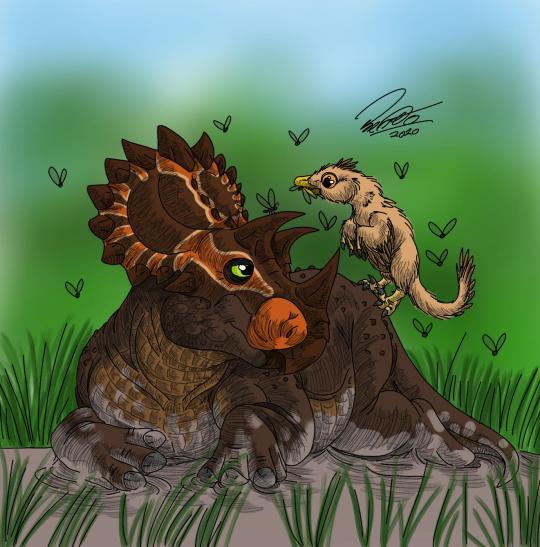
(Note: I am not a professional paleontologist or even biologist. I am just and amateur paleoartist and enthusiast. If my infos are off in some way, feel free to correct them ^^)
-
DINOCEMBER
8 - Regaliceratops peterhewsi (from Latin "Royal horned face")
- Late Cretaceous (68 Ma BCE)
- St. Mary River Formation, Alberta, Canada
Named in 2015, the Regaliceratops is one of many ceratopsids, one of the most recognized groups of dinosaurs due to their large heads adorned with bone frills and horn sets, found in North America, native to the ancient continent of Laramidia, in the western portion of the Western Interior Seaway. Its name comes from the set of bony scutes at the top of its frill, looking kinda like a tiara, being nicknamed by the team that found hit as "Hellboy", both for the relatively short horns at the top of its orbits and due to the difficulty of removing the fossil. from the matrix. This animal, of a size close to that of an Indian rhinoceros, lived in a region of seasonal floodplains and swamps, along with other ceratopsians, nodosaurs, hadrosaurs and raptors, most likely suffering from the tyrannosaur Albertosaurus, native to the same region and geological time.
The Regaliceratops belonged to the Chasmosaurinae family, one of the two large groups of ceratopsians native to North America during the Late Cretaceous, being a close relative of the famous Triceratops of the Hell Creek Formation. Chasmosaurines were characterized by relatively large bone frills, resulting in some of the largest skulls in the animal kingdom, such as the Torosaurus and Pentaceratops, and more prominent brow horns, with small nasal horns. Mostly burly herbivores, these animals would occupy a niche similar to that of large antelopes, deer and cattle in their habitats, using their scissor beaks to uproot shrubs and ferns from the ground, in addition to possibly spending time in mud puddles, like rhinos and buffaloes do today, to scare away insects and other skin parasites, as I decided to represent here. A flock of flies from a large animal such as Regaliceratops would certainly attract small animals in search of a meal, such as a fluff-covered Saurornitholestes chick, which this old female decided to accept.
- Color scheme (escept for the frill) based on a moose (Alces alces)
#dinocember#dinocember2020#regaliceratops#ceratopsian#ceratopsid#ornithischia#chasmosaurinae#alberta#dinosaur#dinossauro#late cretaceous#laramidia#sciart#science illustration#paleobiology#paleontology#hachure#digital art#digital drawing#Digital Artists#artists on tumblr#creature#creature art#creature design#creature concept#floof#saurornitholestes#cretaceous#dinovember
5 notes
·
View notes
Photo

A quick study of Chasmosaurus belli.
Might do more size comparisons like those in the future, they're pretty fun.
Based on the skeletal by Scott Hartman.
#my art#paleoart#chasmosaurus#belli#dinosaur#ceratopsian#ceratopsia#chasmosaurinae#herbivore#ornithischia#animal#prehistoric#size comparison#extinct#north america#Dinosaur Park Formation#Dinosaur Park#cretaceous
10 notes
·
View notes
Photo

Dinovember day 21 - Kosmoceratops
Took a while but here he is. Kosmoceratops was a medium sized ceratopsian with a very ornate skull, that’s why is name means ornamented horned face (kosmos, Greek for ‘ornamented’ and ceratops, Greek for ‘horned face’).
#Kosmoceratops#dinosaurs#Dinovember#drawdinovember#dinovember 2018#Dinosauria#Ceratopsia#Chasmosaurinae#dinosaurios#my drawings#Pyroraptor42#Paleontology#paleontología#paleoart
6 notes
·
View notes
Photo
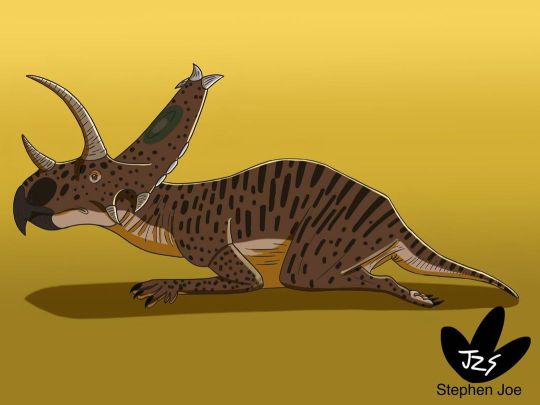
Bisticeratops froeseorum (or should I refer this one in Navajo word “Bisti’bidee’anii’”) is a newly described ceratopsid from Kirtland formation the latter of which is originated from Farmington member. #sketchbookapp #paleoart #artistsoninstagram #bisti #bisticeratops #bisticeratopsfroeseorum #ceratopsidae #chasmosaurinae #ceratopsia #ornithischia #dinosauria #dinosaur #myart https://www.instagram.com/p/ChaCv1fL1wM/?igshid=NGJjMDIxMWI=
#sketchbookapp#paleoart#artistsoninstagram#bisti#bisticeratops#bisticeratopsfroeseorum#ceratopsidae#chasmosaurinae#ceratopsia#ornithischia#dinosauria#dinosaur#myart
0 notes
Photo

Ceratopsian Month #31 -- Triceratops horridus
Of course we’re ending this month with the most famous of the ceratopsians, the dinosaur superstar Triceratops (“three-horned face”).
Dating to the very end of the Cretaceous, between 68 and 66 million years ago, it was the most common ceratopsid in North America at the time, ranging from Alberta, Canada down to Colorado, USA. Two different species are currently recognized within the genus -- T. horridus in the older part of that time range, and T. prorsus in the younger rock layers.
It was one of the very largest ceratopsians, with the biggest individuals reaching sizes of about 7.9-9m (26’-29’6”). Many fossil remains have been found, representing growth stages from juveniles to adults (with Torosaurus speculated to represent the most fully mature individuals), and a lot of variation in exact horn and frill shape is seen between different skulls. One specimen nicknamed “Yoshi’s trike” had some of the longest brow horns of any ceratopsid, with the bony cores alone measuring 1.15m long (3′9″).

Unusually for a chasmosaur, it had a very short and solid frill with no weight-reducing holes, suggesting the structure served a much more defensive role than in other ceratopsids. Damage to the frill bones in some specimens appears to have been caused by other Triceratops, giving support to the popular depiction of these dinosaurs locking horns in fights.
Tooth-marks from the equally-famous Tyrannosaurus have also been found on Triceratops bones. Not all of these predator-prey encounters were fatal, however, with some specimens showing evidence of healing around the damaged areas.
Fossilized skin impressions show that Triceratops was scaly -- but with scales unlike those of any other known dinosaur, showing large polygonal scales interspersed with even bigger knobbly scales with odd “nipple-shaped” conical projections in their centers. It’s possible that the “nipples” may have supported larger structures (as I’ve illustrated above), but unfortunately no official scientific description of this skin has been published yet and details about it are vague.
And with this final entry, here’s the chasmosaur evolutionary tree:

#science illustration#paleontology#paleoart#palaeoblr#ceratopsian month 2017#triceratops#triceratopsini#chasmosaurinae#ceratopsidae#neoceratopsia#ceratopsian#marginocephalia#neornithischia#ornithischia#dinosaur#archosaur#the 'toromorph' debate#art#have some actually scaly dinosaurs#triceratops' weird nipple-scales#go home evolution you're drunk
225 notes
·
View notes
Text
Dinofact #60
There has been debate over the function of the frills and horns on Triceratops and other similar species. Most recent interpretations find that they would have been used in species identification and courtship, similar to modern ungulates, as opposed to fending off predators.
Source: Wikipedia
#dinosaur#dinosaurs#paleontology#triceratops#triceratops horridus#triceratops prorsus#cerotopsia#cerotopsian#cerotopaians#ceratopsidae#chasmosaurinae#triceratopsini#triceratopsin#triceratopsins#chasmosaurine#chasmosaurines#ceratopsid#ceratopsids#ungulate#ungulates#fun facts#trivia#dinosaur trivia#dinosaur fun facts#23rd#october#2022#october 23rd#october 2022#october 23rd 2022
9 notes
·
View notes
Note
why are there some taxa like chasmosaurinae where like. there was, very evidently, a more obvious type genus to choose. more well-known, discovered earlier, etc. but nope.
Naming a new dinosaur is something most paleontologists dream of doing, so they find any justification to do so.
Also it turns out that species often have very few skeletal differences within a genus so we’re probably grossly underestimating diversity as it is, so that’s not necessarily a bad thing
24 notes
·
View notes
Photo
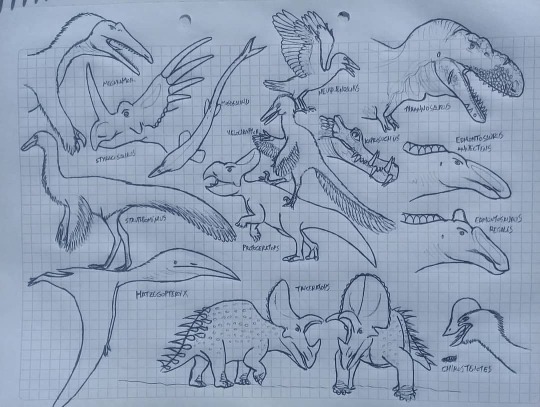
Here are some quick mesozoic tetrapods sketches. #tyrannosaurus #tyrannosauridae #tyrannosaurusrex #edmontosaurus #hadrosaururine #duckbilleddinosaur #chirostenotes #oviraptorid #triceratops #chasmosaurinae #ceratopsian #protoceratops #leptoceratopsidae #velociraptor #velociraptorinae #dromaeosauridae #kaprosuchus #notosuchia #neuquenornis #enantiornithine #mosasauridae #styracosaurus #centrosaurinae #tetanurae #megaraptor #struthiomimus #ornithomimid #hatzegopteryx #azdarchid https://www.instagram.com/p/B61PNdpFbRM/?igshid=vdo0kvtdvkjl
#tyrannosaurus#tyrannosauridae#tyrannosaurusrex#edmontosaurus#hadrosaururine#duckbilleddinosaur#chirostenotes#oviraptorid#triceratops#chasmosaurinae#ceratopsian#protoceratops#leptoceratopsidae#velociraptor#velociraptorinae#dromaeosauridae#kaprosuchus#notosuchia#neuquenornis#enantiornithine#mosasauridae#styracosaurus#centrosaurinae#tetanurae#megaraptor#struthiomimus#ornithomimid#hatzegopteryx#azdarchid
0 notes
Text
A young T. rex being taught a lesson in humility by its desired meal.
Triceratops horridus
('three-horned face, rough/rugose')
Chasmosaurinae Triceratopsini
T. horridus is the type species; also represented by T. prorsus ('straightforward').
Tyrannosaurus rex
('tyrant reptile, king')
Tyrannosaurinae Tyrannosaurini
Various formations, western Canada and USA, east of the Rockies.
Upper Cretaceous, ~68 - 66 Ma.
~
Artwork by Mohamad Haghani.

Daily Dino Fact #26
3 notes
·
View notes